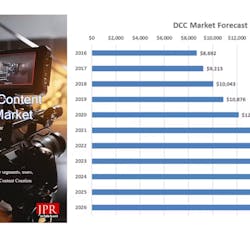According to Parks Associates, the average standalone pay TV service ARPU declined 10% from 2016 to 2018, while consumer-reported monthly spending on pay TV declined from $84 to $76. The research house says pricing pressure for consumer services is forcing increasing conflict in carriage negotiations, which in turn fuels the interest among providers in continued vertical and horizontal consolidation.
Self-reported expenditures on non-pay TV home video entertainment also declined 30% per month over the past seven years, peaking at nearly $40 in 2014 to slightly over $20 at the end of 2018, Parks says. Spending on DVD and Blu-ray packaged media has steadily declined since 2012, while spending on movie theaters declined by 50% from 2014 to 2018. Spending on Internet video is the only category to hold steady throughout the time frame, staying at $8-9 per month since 2014, a combination of streaming and downloaded content from the internet.
"Traditional pay TV providers (MVPDs) have faced continued subscriber losses due to increasing consumer choice from OTT services, so they are deploying skinny bundles and vMVPD services to create more choice among viewers," said Elizabeth Parks, president of Parks Associates. "For pay TV service providers, traditional and online, they are exploring new areas in content ownership and development, and to be successful in these efforts, understanding consumer activity and motivation related to adoption and use of their services is critical."
"Subscription online video is the only growth category for consumer-paid video entertainment beyond pay TV. Operators, struggling with declining ARPU for standalone pay TV services, are anxious to leverage this trend," said Brett Sappington, senior research director and principal analyst at Parks. "Operators are taking differing approaches. Some, including Comcast and DISH, are offering subscriptions to third-party OTT video services and are integrating them into their discovery interfaces. Partnering gives operators a chance to serve as content aggregator, a familiar position. Others, including AT&T and DISH, are expanding their competitive reach online and have introduced vMVPD services."
Other findings indicate:
20% of U.S. broadband households do not have a pay TV service.
NPS for traditional pay TV services is weaker than for other content service types.
In 2018, the average number of connected devices per broadband household, excluding smart home devices, reached 8.4.
12% of U.S. broadband households eliminated pay TV service (cut the cord) in 2018.





